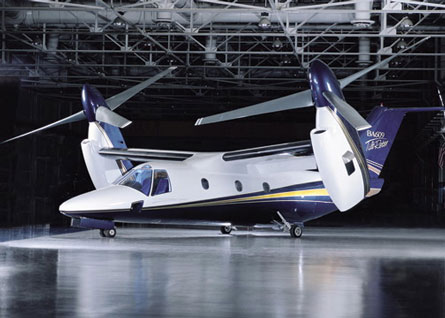Jon Lake
Though previously shown at Le Bourget in mock-up form, the Bell-Agusta BA609 Tiltrotor is making its full Paris debut this year, and looks set to be the star of the flying display.
The aircraft’s appearance comes 26 years after its forebear, the Bell XV-15 (which pioneered the configuration used by the BA609 and by the larger Bell/Boeing V-22), made its public debut here at Paris.
The aircraft at Le Bourget is the Italian assembled second prototype, which made its maiden flight on 9 November 2006, and its first public appearance last month at the Airshow 'Giornata Azzurra 2007' at the Italian Air Force base at Pratica di Mare.

Evaluation
The aircraft was at Pratica for evaluation by the Reparto Sperimentale Volo (the Italian Air Force’s Flight Test and Evaluation Unit).
The BA609 was originally developed by the V-22 programme partners Bell and Boeing. The two companies announced their intention to develop a nine-seat civil tilt-rotor in 1996, unveiling the Bell/Boeing 609 on 18 November 1996. Boeing withdrew from the programme as a risk-sharing partner in early 1998 and its place was taken by Agusta (a long-standing Bell collaborator and partner) in September that year.
The first of four planned BA609 prototypes made its maiden flight at the Bell Flight Research Center in Arlington, Texas on 6 March 2003, four years later than had been originally planned. The second aircraft made its first flight from the AgustaWestland facility at the Italian Air Force base at Cameri, on 9 November 2006. Development is now said to be proceeding rapidly, and the programme can, to a certain extent, ‘piggyback’ on the back of the V-22, which is now in frontline service, rapidly amassing flying hours and refining tilt-rotor handling and operating procedures.
The manufacturers claim that the nine-seat BA609 provides a “totally new approach to corporate transport, search and rescue, and law enforcement missions” and say that the aircraft can fly mission profiles that are impossible for conventional aircraft or helicopters, combining the vertical takeoff and landing capabilities of the helicopter with the speed, altitude, comfort, reliability, and economy of a typical turboprop executive aircraft.
Cost-effective
Bell claims that the BA609 will offer its operators the most cost-effective point-to-point transport at ranges of up to 750 nautical miles, and that it will provide the fastest possible way of travelling from one downtown area to another, flying at cruise speeds of up to 275 knots and altitudes up to 25,000 ft. The aircraft is designed to meet the requirements of the offshore industry as well as those of corporate customers, and promises to fly typical offshore missions in about half the time.
The Bell-Agusta Aerospace Company says that a senior executive could fly from his home or hotel outside London directly to a Munich meeting (a flying time of about an hour), and then on to meetings in Zurich and Milan, all using city centre heliports to minimise the need for ground transport, and then returning home in time for dinner!
Today, such an agenda would require a minutely planned combination of helicopters and chartered and scheduled airline flights, if it was possible at all.
The Bell-Agusta Aerospace Company is cautious about making detailed predictions about likely sales before line positions are booked via non-refundable deposits. They do, however, claim that approximately 40 customers have signed purchase/sales agreements for around 70 aircraft.
Source: Flight Daily News
















